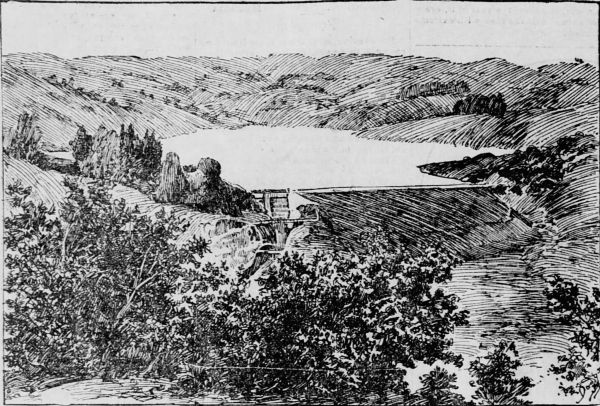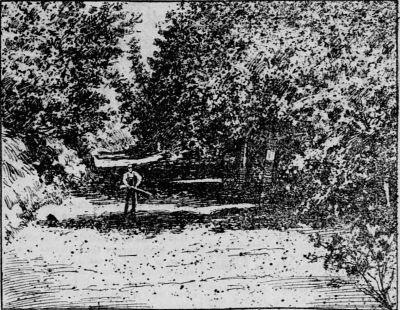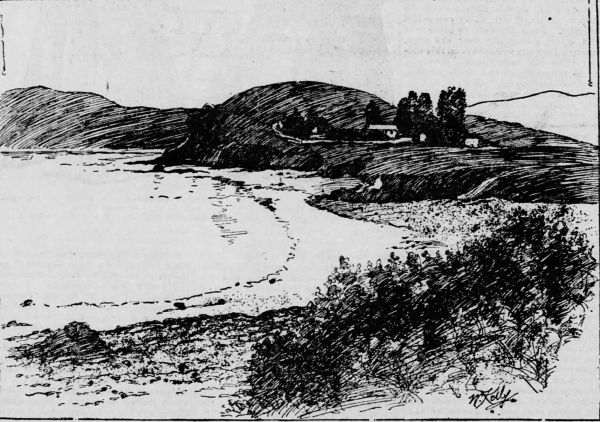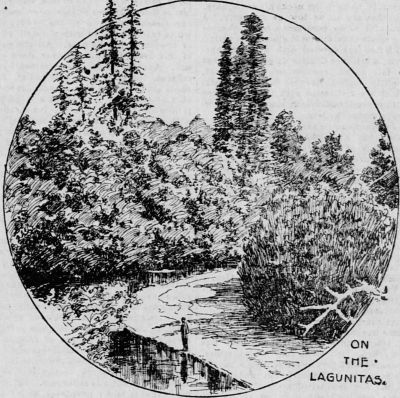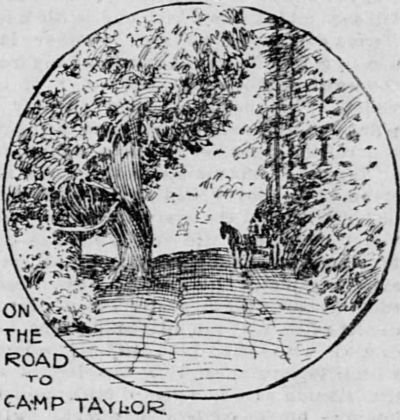Unfrequented Bicycle Roads in the Vicinity of San Francisco - The San Francisco Call, 18 Apr 1897
Unfrequented Bicycle Roads in the Vicinity of San Francisco
You ride the bicycle? Of course, or at least you are thinking more or less seriously of learning to master it, with a view of holding a place in the procession now rapidly nearing the end of the century on wheels.
In either case this article may furnish you a few suggestions, provided you are not a "scorcher" or ambitious to become one. The "scorcher" does not ride for pleasure — he chases records. His chief aim in life is to cover a certain number of miles in a little less than a given number of minutes. Like a will o' the wisp the record flits before him, and to grasp it, even though he holds it but for a brief space, is to become the lion of an hour in the cycling world. He passes the country, to be sure, but he doesn't see it. What if the sky be blue, the wayside gorgeous with springtime flowers, the overhanging branches tenanted by sweetest songsters? The "scorcher" has no time to note these things. But withal he's a good fellow, and this is not meant to disparage his importance. Without him there would be no racing, and without contests of speed to stimulate the ambition of wheelmen even those who ride simply for enjoyment would take less interest in the sport.
Yet the vast majority of men and women who ride the wheel do so principally because it combines in the highest degree moderate exercise and exhilarating recreation. With more or less time at command they are fond of leisurely spins through the park, occasional trips to San Leandro or Haywards, and perhaps, once in many months, a journey even so far as San Jose.
They would fain go elsewhere, but know not how. This is a city of hills, and having made several fruitless efforts to strike out in search of ridable roads they have abandoned the quest. Travel over the beaten paths becomes monotonous, the once attractive scenery loses its charm, and in nine cases out of ten the bicycle is temporarily relegated to the storeroom.
Now this is all wrong. The cycling season is here ahead of time this year. So get out your wheel and prepare to readjust your bearings as to the lay of the land hereabouts. Come with me on a few excursions, none of which will take you far from home. Perhaps when you return it may be with fresh ideas regarding the advantages of this badly paved, top-tilted town as a cycling center.
Before starting into the country look well to the condition of your wheel. See that every nut is tight, that the tires are of the proper firmness, that sufficient oil has been applied, and above all have the chain well lubricated. With these essentials attended to there's little danger of annoying delays. Making repairs by the roadside is simple, theoretically, but in practice is not conducive to serenity of temper.
And don't forget your shoes. For touring they should come high enough to just cover the ankle-joint. There is dust to be kept out and maybe seme hard knocks to be averted.
We will not go to the Cliff, nor through the Presidio, nor to Ingleside. These are all old familiar places. Of the Mission road the least said the better — it is steep and never in good condition. Although the bay road, which winds in long curves around the shallow waters of the western shore, is certainly picturesque it is also rather rough and is guarded by the formidable five-mile hill.
If you are a strong rider and feel that duty calls you to San Jose or any of the intermediate towns take the bay road. If you don't want to get "that tired feeling" at the beginning of your trip take the train to Milbrae. From this point the road is excellent, but instead of continuing on to the Garden City turn abruptly to the left at Burlingame, cross the railroad track and with a swerve to the right reach Mateo beach.
Here you may pluck wild flowers on the shore or plunge into the placid waves that ripple over the gravelly bottom. The water is never very cold and there are no dangerous currents. After breasting the tide a while take a rub down, and you will wonder why the wheel runs so lightly on the return trip.
From San Mateo or Belmont there are several roads leading into the hills, and even beyond to the settlements along the ocean. But these, with the exception of the run to the Crystal Springs reservoir, which is well worth a visit, are hard climbs to make and will scarcely compensate for the outlay of time and muscle.
No need to more than mention the road to Haywards or the racing course over the famous San Lorenzo triangle. These are traversed weekly by thousands of wheelmen. Yet seldom do any turn aside to enjoy the varied beauties of Lake Chabot or the nearer by loveliness of Laundry Farm.
It's a warm day, but there's sure to be some shade, so let us have a look at Lake Chabot and the Castro Valley.
The dam at Lake Chabot is only two miles from San Leandro as the crow flies, and he does fly here sometimes. Just at the base of the little triangular town square, turn to the left into Estudillo avenue, a splendid street, straight as an arrow and lined on either side with lofty locust trees, their branches almost interlacing. At the end of the avenue is a little whitewashed cottage, evidently the abode of a farmer who is plowing near by, but on the ridge of the steep roof is the faded sign of a saloon. It has outlived its usefulness and is an incongruous feature of the sylvan scene.
Proceeding about a quarter of a mile we reach the parting of the ways — a fork in the road that is quite misleading, for the most-traveled way is the one not to follow. Take the branch on the right that runs up the steep side of a hill. It's only 100 yards to the top, but it's easier to walk. Here the soil is adobe and for a short distance is badly broken up, but later in the season it will be all right. The road is cut out of the side of a chain of hills. Below, to the left, is a narrow, deep valley, thickly wooded, but one looks over the tops of the highest trees. The sweet scent of willows comes on the air, and the gurgling of water over a pebbly bed is heard.
A little further on the lake itself bursts into view. Blue and clear as the sky above it stretches away and away between breaks in the hills, seen here and there through openings in the overhanging foliage. Involuntarily one thinks of pictures that he has seen of the lakes of Killarney.
Directly opposite the eminence on which we stand is the great dam, covered with the greenest of grass. At its base a few head of cattle are feeding, and beyond the white sail of a boat glints in the sun. The water is up to the limit, and a foam-crested cataract pours, under a bridge of stone, and is guided through an open conduit into the vale below. The cascade roars like a miniature Niagara, and is the only sound that breaks the stillness of the spring day.
The road winds for some distance above the shores of the lake, which is apparently of vast extent, though in reality it is less than six miles long. Ferns and flowers grow on the bank to the right, and the wild honeysuckle hangs in festoons here and there.
On a rocky point sits a lone fisherman. He opens a bulging bag and displays a fine mess of trout, carp, catfish aad a few minnows for small change.
"Does the water company care?" "Well, maybe, but it's a long way from the office," is the philosophical reply.
By a gradual descent the road reaches the lowlands at the head of the lake, which is left behind and the Castro Valley entered. Here are the homes of many small farmers and stockmen. In places the wheeling is hard, but the roads will soon get broken down. Rushing down a sharp declivity between two farmhouses we are again on the San Leandro road, this time at a bridge near Haywards, having made a detour of about eight miles.
If this ride seems a bit too long go up into the canyon at Laundry Farm. A little more than a mile from Fruitvale a crossroad leads to Mills College. It is smooth and well kept. Follow it past the bridge at the entrance of the seminary, and if the grade is too hard for you walk a few yards to the top of the incline. Then comes a gentle slope. If you keep on the main drive you'll pass through a pretty piece of country, but will soon get into the foothills and find it advisable to retrace your way. But turn sharply to the left and hold the wheel in check until you reach the bed of the creek below Leona Heights. Guided by the stream, which at one place you must cross on a single plank, pass the rock-crushing plant, fed by an automatic railway, and enter the glen, a favorite resort of picnickers, but where one seldom sees a bicycle. Beyond this it is not pleasant to ride, though there are paths which may be pursued for some distance in various directions. But climb to the top of one of the many ridges and you may obtain a splendid view of Oakland, Alameda, Berkeley, the bay, San Francisco and the Golden Gate. The trip is a short one and the recompense more than ample.
Back of Oakland is the road into Jack Hays Canyon, starting from Temescal, which is extremely picturesque, but rather too hilly for real enjoyment. The same may be said of the route into Moraga Valley by way of the Fish ranch. The ambitious road-rider, however, will do well not to miss the scenic charms here to be found.
Should you desire to visit Martinez while on this side of the bay, take the county road at Golden Gate station, and you will find fairly good wheeling, barring occasional grades, where it is advisable to walk. Indeed, nothing promotes pedestrianism like cycling in the Coast Range.
For a change of scene turn to the north. The dense forests find rushing rivulets of Marin will be marvelous to many. True, they may be seen from car windows, but stereotyped views soon fail to please. You must get close to nature's heart if you would feel it beat.
Take a day off, or go on Sunday — after church, of course. Cross to Sausalito, then steer toward Tamalpais, once beautiful to behold, now cruelly gashed by ruthless progress in the guise of a scenic railway. The cross-like scar made by an avalanche is still there, but does not mar the mountain's face as does the work of man.
The road has many bends, but in half an hour you may reach Mill Valley and ride into the redwoods. Rest here a while, see the old mill, the three wells and the cascade, then take a path little favored by cyclists. Leave the village behind, sprint through "Jagtown" and cross the narrow-gauge track near Alto station. Then on across the marsh and in and out the indentations along the shoreline made by the northern arms of Richardsons Bay until Tiburon is reached, and a boat for the City may be taken. The road is not bad, except in places, and only once or twice is it necessary to dismount on account of the grade.
But from no other point can one see Sausalito, Belvedere, Tiburon and San Francisco in one picture, with Alcatraz and Angel islands appearing in unexpected places. There are some shingly beaches here, and occasionally one may find a few youthful bathers careless of the conventionalities.
Arriving at Tiburon, if there is time to spare, take the broad-gauge train through the tunnels to Green Brae, where are moored a rare collection of arks, none of which Noah would recognize. From this place there is a good road to San Quentin, naturally starting on the down grade, blotted viewing the prison you may — if not legally embarrassed — continue the ride to San Rafael, Petaluma, Fairfax, San Anselmo or Ross station.
From San Anselmo begins the cycler's road to Camp Taylor, and up the Russian River or its picturesque tributaries. From Ross station you will find it worth while to follow the Lagunitas to Liberty.
To get into the depths of a redwood forest you must go to Camp Taylor or Cazedero. The start is made from San Anselmo, but it is necessary to walk over White's Hill, the road being too steep and crooked to ride in either direction. Once beyond this forbidding eminence you plunge into a real wilderness. Some of the trees are veritable giants. Two cyclists with their wheels may stand within the hollow trunk of one old redwood that towers 200 feet overhead. It is difficult to realize that this is only a two hours' ride from home.
The river now is running full and is crossed by many a rustic bridge. Dragonflies, glistening in the sunshine, dart before your eyes and song birds are everywhere. Why waste your idle hours in the city? Up, mount your wheel and find health and happiness here in the wildwood.
